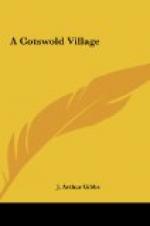At Calmsden—a tiny isolated hamlet near North Cerney—is a grey and weather-beaten wayside cross of beautiful Gothic workmanship, erected (men say) by the Knights Templar of Quenington; and there are ancient crosses or remnants of them at Cirencester, Eastleach, Harnhill, Rendcombe, Stow-on-the-Wold, and many other places in the district. But few of these old village crosses still stand intact in their pristine beauty. May they never suffer the terrible fate of a very beautiful one which was erected in the fourteenth century at Bristol! Pope, writing a century and a half ago, describes it as “a very fine old cross of Gothic curious work, but spoiled with the folly of new gilding it, that takes away all the venerable antiquity.”
Happily there is no likelihood of the ancient crosses in the Cotswolds being decorated by a coating of gold. The precious metal is all too scarce there, even if the good taste of the country folk did not prohibit it.
I have spoken before of the ancient barns. Every hamlet has one or more of these grand old edifices, and there are often as many as three or four in a small village. In some of these large barns the tithe was gathered together in kind, until rather more than sixty years ago it was converted into a rent charge.
Tithe was made on all kinds of farm produce. The vicar’s man went into the cornfields and placed a bough in every tenth “stook”; then the titheman came with the parson’s horses and took the stuff away to the barn. The tithe for every cock in the farmyard was three eggs; for every hen, two eggs. Besides poultry, geese, pigs, and sheep, the parson had a right to his share of the milk, and even of the cheeses that were made in his parish.
In an ancient manuscript which the vicar of Bibury lately acquired, and which contains the history of his parish since the Conquest, are set down some interesting and amusing details concerning tithe and the cash compensations that had been paid time out of mind. The entries form part of a diary kept by a former incumbent, and were made nearly two hundred years ago.
“For every new Milch Cow three pence.
“For every thorough Milch Cow one penny.
“N.B. Nothing is paid for a dry cow, and therefore tithe in kind must be paid for all fatting cattle.
“For every calf weaned a half penny.
“For every calf sold four pence or the left shoulder.
“For every calf killed in the family four pence or the left shoulder.
“I have heard that one or two left shoulders of veal were paid to the widow Hignall at Arlington when she rented the tithes of Dr. Vannam, but I have received none.”
Then follows an annual account of the value of the tithes of the parish (about five thousand acres), from 1763 to 1802, by which it appears that the year 1800 was the best during these four decades. Here is the entry:—




